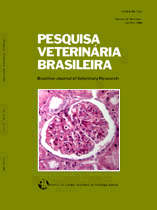 |
|
|
|
Year 2011 - Volume 31, Number 7
|

|
Morphological features of muscle biopsies from horses of a myopathy outbreak, 31(7):579-585
|
ABSTRACT.- Amorim R.M., Rino A.S., Dal-Pai M., Borges A.S. Oliveira Filho J.P., Freitas N.P.P., Maia L. & Rezende L.A.L. 2011. [Morphological features of muscle biopsies from horses of a myopathy outbreak.] Aspectos morfológicos de biópsias musculares em equinos com miopatia em forma de surto. Pesquisa Veterinária Brasileira 31(7):579-585. Departamento de Clínica Veterinária, Faculdade de Medicina Veterinária e Zootecnia, Universidade Estadual Paulista, Campus de Botucatu, Distrito de Rubião Júnior s/n, Botucatu, SP 18618-970, Brazil. E-mail: rmamorim@fmvz.unesp.br
Equine myopathies are classified according clinic, morphologic and molecular features in three groups: Non-exertional, exertional, and abnormal muscle membrane conduction. In spite the advances in diagnostic, the literature has reported outbreaks of equine myopathy without clear etiology in several countries. The aim of this study was to describe the histological and histochemical findings of muscle biopsies in an outbreak of equine myopathy. Seven 18 to 24-month-old Quarter horses showed clinical signs of myopathy. Five horses presented mild clinical signs and two horses had severe clinical signs with recumbency. Muscle biopsies were obtained from gluteal medium muscle by percutaneous technique with Bergstrom needle in all affected horses. Muscle samples were processed by histological (HE, modified gomori-trichrome) and histochemical (PAS, NADH, ATPase) technics. In animals with mild clinical signs, ragged red fibers type I and IIA, related to the oxidative metabolism dysfunction of mitochondria, was the main abnormality found. Muscle fiber atrophy and presence of subsarcolemmal aggregates in type I and IIA muscle fibers were also observed. More severe affected horses presented inflammatory infiltrate, proliferation of collagen, phagocytosis, necrosis and calcification. Based on the morphological findings, vitamin E therapy response associated with the low mortality when compared with atypical myopathy reports, We concluded that this outbreak was triggering for mitochondrial lesions, characterized by ragged red muscle fibers, probably due a breakdown homeostasis in vitamin E and Se, being compatible with nutritional myopathy diagnosis. |
| |
|
|
| |
|
 |